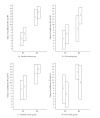Overall Memory Impairment Identification with Mathematical Modeling of the CVLT-II Learning Curve in Multiple Sclerosis
- PMID: 22745911
- PMCID: PMC3382211
- DOI: 10.1155/2012/312503
Overall Memory Impairment Identification with Mathematical Modeling of the CVLT-II Learning Curve in Multiple Sclerosis
Abstract
The CVLT-II provides standardized scores for each of the List A five learning trials, so that the clinician can compare the patient's raw trials 1-5 scores with standardized ones. However, frequently, a patient's raw scores fluctuate making a proper interpretation difficult. The CVLT-II does not offer any other methods for classifying a patient's learning and memory status on the background of the learning curve. The main objective of this research is to illustrate that discriminant analysis provides an accurate assessment of the learning curve, if suitable predictor variables are selected. Normal controls were ninety-eight healthy volunteers (78 females and 20 males). A group of MS patients included 365 patients (266 females and 99 males) with clinically defined multiple sclerosis. We show that the best predictor variables are coefficients B3 and B4 of our mathematical model B3 ∗ exp(-B2 ∗ (X - 1)) + B4 ∗ (1 - exp(-B2 ∗ (X - 1))) because discriminant functions, calculated separately for B3 and B4, allow nearly 100% correct classification. These predictors allow identification of separate impairment of readiness to learn or ability to learn, or both.
Figures







Similar articles
-
The application of the first order system transfer function for fitting the California Verbal Learning Test learning curve.J Int Neuropsychol Soc. 2010 May;16(3):443-52. doi: 10.1017/S1355617709991457. Epub 2010 Mar 1. J Int Neuropsychol Soc. 2010. PMID: 20188012
-
Assessment of the learning curve from the California Verbal Learning Test-Children's Version with the first-order system transfer function.Child Neuropsychol. 2011;17(4):330-46. doi: 10.1080/09297049.2010.541234. Child Neuropsychol. 2011. PMID: 21390915
-
Brief and cost-effective tool for assessing verbal learning in multiple sclerosis: Comparison of the Rey Auditory Verbal Learning Test (RAVLT) to the California Verbal Learning Test - II (CVLT-II).J Neurol Sci. 2019 May 15;400:104-109. doi: 10.1016/j.jns.2019.03.016. Epub 2019 Mar 19. J Neurol Sci. 2019. PMID: 30913522 Free PMC article.
-
Where have I heard that before? A validity study of source memory indices from the California Verbal Learning Test - Second edition.Clin Neuropsychol. 2020 Apr;34(3):541-560. doi: 10.1080/13854046.2019.1613559. Epub 2019 May 14. Clin Neuropsychol. 2020. PMID: 31084399 Free PMC article.
-
The use of the first order system transfer function in the analysis of proboscis extension learning of honey bees, Apis mellifera L., exposed to pesticides.Bull Environ Contam Toxicol. 2012 Apr;88(4):559-62. doi: 10.1007/s00128-011-0512-8. Epub 2012 Jan 5. Bull Environ Contam Toxicol. 2012. PMID: 22218746
Cited by
-
Learning in Plants: Lessons from Mimosa pudica.Front Psychol. 2016 Mar 31;7:417. doi: 10.3389/fpsyg.2016.00417. eCollection 2016. Front Psychol. 2016. PMID: 27065905 Free PMC article. Review.
References
-
- Compston A, Coles A. Multiple sclerosis. The Lancet. 2008;372(9648):1502–1517. - PubMed
-
- Miller DH, Albert PS, Barkhof F, et al. Guidelines for the use of magnetic resonance techniques in monitoring the treatment of multiple sclerosis. Annals of Neurology. 1996;39(1):6–16. - PubMed
-
- Fisher E, Lee JC, Nakamura K, Rudick RA. Gray matter atrophy in multiple sclerosis: a longitudinal study. Annals of Neurology. 2008;64(3):255–265. - PubMed
-
- Benedict RHB, Cookfair D, Gavett R, et al. Validity of the minimal assessment of cognitive function in multiple sclerosis (MACFIMS) Journal of the International Neuropsychological Society. 2006;12(4):549–558. - PubMed
-
- Heaton RK, Nelson LM, Thompson DS. Neoropsychologicl findings in relapsing—remitting and chronic—progressivd multiple sclerosis. Journal of Consulting and Clinical Psychology. 1985;53(1):103–110. - PubMed
LinkOut - more resources
Full Text Sources

